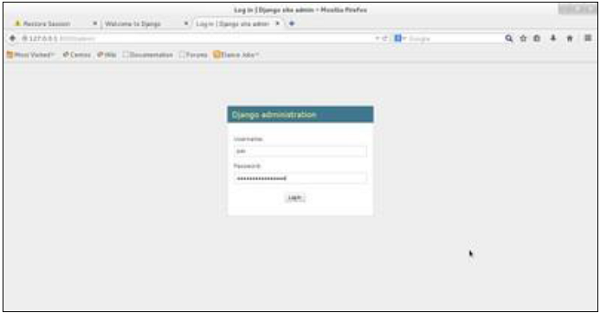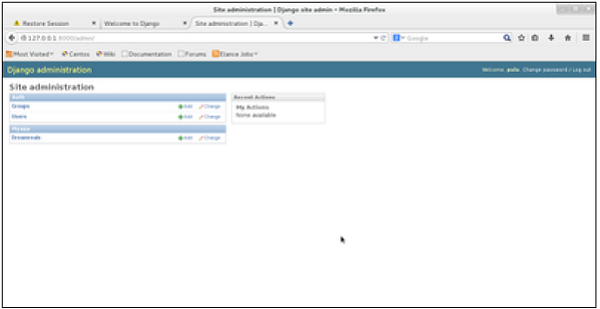Django provides a ready-to-use user interface for administrative activities. We all know how an admin interface is important for a web project. Django automatically generates admin UI based on your project models.
Starting the Admin Interface
The Admin interface depends on the django.countrib module. To have it working you need to make sure some modules are imported in the INSTALLED_APPS and MIDDLEWARE_CLASSES tuples of the myproject/settings.py file.
For INSTALLED_APPS make sure you have −
INSTALLED_APPS = ( 'django.contrib.admin', 'django.contrib.auth', 'django.contrib.contenttypes', 'django.contrib.sessions', 'django.contrib.messages', 'django.contrib.staticfiles', 'myapp', )
For MIDDLEWARE_CLASSES −
MIDDLEWARE_CLASSES = ( 'django.contrib.sessions.middleware.SessionMiddleware', 'django.middleware.common.CommonMiddleware', 'django.middleware.csrf.CsrfViewMiddleware', 'django.contrib.auth.middleware.AuthenticationMiddleware', 'django.contrib.messages.middleware.MessageMiddleware', 'django.middleware.clickjacking.XFrameOptionsMiddleware', )
Before launching your server, to access your Admin Interface, you need to initiate the database −
$ python manage.py migrate
syncdb will create necessary tables or collections depending on your db type, necessary for the admin interface to run. Even if you don't have a superuser, you will be prompted to create one.
If you already have a superuser or have forgotten it, you can always create one using the following code −
$ python manage.py createsuperuser D:\lab\batch28\myproject>python manage.py createsuperuser Username (leave blank to use 'sboda'): sboda Email address: Password: Password (again): This password is too short. It must contain at least 8 characters. This password is too common. Bypass password validation and create user anyway? [y/N]: y Superuser created successfully.
Now to start the Admin Interface, we need to make sure we have configured a URL for our admin interface. Open the myproject/url.py and you should have something like −
from django.conf.urls import patterns, include, url from django.contrib import admin admin.autodiscover() urlpatterns = patterns('', # Examples: # url(r'^$', 'myproject.views.home', name = 'home'), # url(r'^blog/', include('blog.urls')), url(r'^admin/', include(admin.site.urls)), )
Now just run the server.
$ python manage.py runserver
And your admin interface is accessible at: http://127.0.0.1:8000/admin/

Once connected with your superuser account, you will see the following screen −

That interface will let you administrate Django groups and users, and all registered models in your app. The interface gives you the ability to do at least the "CRUD" (Create, Read, Update, Delete) operations on your models.
######################################################
5.
D:\django\myproject>python manage.py createsuperuser
Username (leave blank to use 'sboda'):
Email address: algorithm.class@gmail.com
Password:
Password (again):
Superuser created successfully.
6. Python manage.py runserver
7. http
8. At this stage we have our "myapp" application, now we need to register it with our Django project "myproject". To do so, update INSTALLED_APPS tuple in the settings.py file of your project (add your app name) −
INSTALLED_APPS = ( 'django.contrib.admin', 'django.contrib.auth', 'django.contrib.contenttypes', 'django.contrib.sessions', 'django.contrib.messages', 'django.contrib.staticfiles', 'myapp', )
D:\django\myproject>python manage.py makemigrations
Hello
Migrations for 'news':
news\migrations\0001_initial.py
- Create model Article
- Create model Reporter
- Add field reporter to article
D:\django\myproject>python manage.py migrate
Hello
Operations to perform:
Apply all migrations: admin, auth, contenttypes, myapp, news, sessions
Running migrations:
Applying news.0001_initial... OK
D:\django\myproject>
Now to start the Admin Interface, we need to make sure we have configured a URL for our admin interface. Open the myproject/url.py and you should have something like −
from django.conf.urls import patterns, include, url from django.contrib import admin admin.autodiscover() urlpatterns = patterns('', # Examples: # url(r'^$', 'myproject.views.home', name = 'home'), # url(r'^blog/', include('blog.urls')), url(r'^admin/', include(admin.site.urls)), )
#######################################
